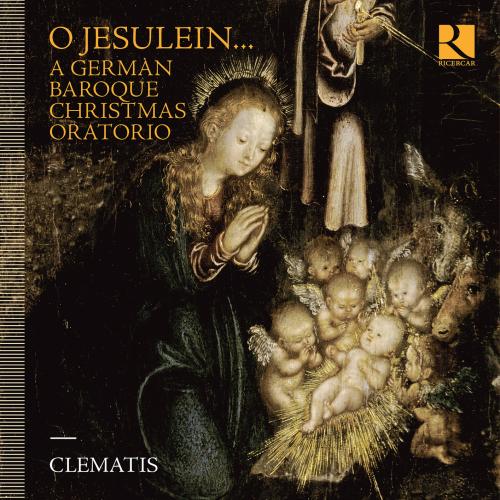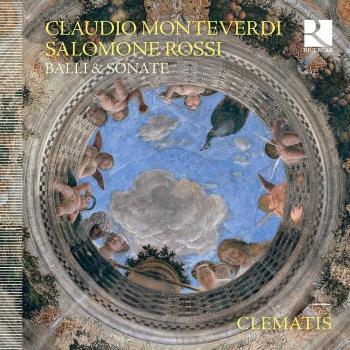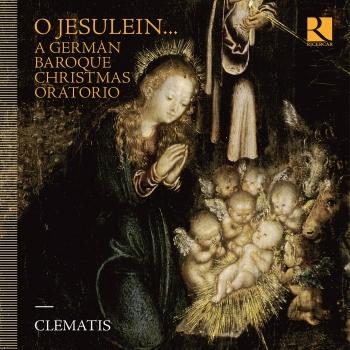
O Jesulein... A German Baroque Christmas Oratorio Clematis
Album info
Album-Release:
2022
HRA-Release:
14.10.2022
Label: Ricercar
Genre: Classical
Subgenre: Choral
Artist: Clematis
Composer: Johann Christoph Bach (1642-1703), Dietrich Buxtehude (1637-1707), Andreas Hammerschmidt (1612-1675), Michael Praetorius (1571-1621), Johann Schelle (1648-1701), Heinrich Schütz (1585-1672), Thomas Selle (1599-1663), Franz Tunder (1614-1667), Johann Rudolf Ahle (1626-1673)
Album including Album cover Booklet (PDF)
- Wolfgang Carl Briegel (1626 - 1712): Dies ist der Tag des Fröhligkeit:
- 1 Briegel: Dies ist der Tag des Fröhligkeit 04:34
- Andreas Hammerschmidt (1611 - 1675): Maria gegrüsset seist du:
- 2 Hammerschmidt: Maria gegrüsset seist du 05:38
- Johann Schelle (1648 - 1701): Nun komm der Heiden Heiland:
- 3 Schelle: Nun komm der Heiden Heiland 02:35
- Christoph Bernhard (1628 - 1692): Fürchtet euch nicht:
- 4 Bernhard: Fürchtet euch nicht 04:00
- Andreas Hammerschmidt: Freude, grosse Freude:
- 5 Hammerschmidt: Freude, grosse Freude 01:12
- Michael Praetorius (1571 - 1621): Es ist ein Ros entsprugen:
- 6 Praetorius: Es ist ein Ros entsprugen 02:06
- Christian Flor (1626 - 1697): Pastores currite in Bethlehem:
- 7 Flor: Pastores currite in Bethlehem 04:11
- Andreas Hammerschmidt: Ach mein herzliebes Jesulein:
- 8 Hammerschmidt: Ach mein herzliebes Jesulein 01:46
- Franz Tunder (1614 - 1667): Ein kleines Kindelein:
- 9 Tunder: Ein kleines Kindelein 02:33
- Michael Praetorius: Puer natus in Bethlehem:
- 10 Praetorius: Puer natus in Bethlehem 02:24
- Heinrich Schütz (1585 - 1672): O bone Jesu, fili Mariae, SWV 471:
- 11 Schütz: O bone Jesu, fili Mariae, SWV 471 06:05
- Thomas Selle (1599 - 1663): Angelus ad Josephum:
- 12 Selle: Angelus ad Josephum 06:39
- Dietrich Buxtehude (1637 - 1707): Wie schön leuchtet der Morgenstern, BuxWV 223:
- 13 Buxtehude: Wie schön leuchtet der Morgenstern, BuxWV 223: I. Versus 1. Allegretto con moto 01:01
- Andreas Hammerschmidt: Wie bin ich doch so hertzlich froh:
- 14 Hammerschmidt: Wie bin ich doch so hertzlich froh 02:54
- Wo ist der neugeborne König:
- 15 Hammerschmidt: Wo ist der neugeborne König 04:56
- Johann Rudolph Ahle (1625 - 1673): Herr, nun lässest du deiner Diener:
- 16 Ahle: Herr, nun lässest du deiner Diener 04:58
- Samuel Capricornus (1628 - 1665): Sonata ab 8 Instrument:
- 17 Capricornus: Sonata ab 8 Instrument: I. [...] 01:25
- Andreas Hammerschmidt: Mein Sohn, warum hast du uns getan?:
- 18 Hammerschmidt: Mein Sohn, warum hast du uns getan? 04:15
- David Pohle (1624 - 1695): Nascitur Immanuel:
- 19 Pohle: Nascitur Immanuel 08:20
- Johann Christoph Bach (1642 - 1703): O Freudenzeit, o Wundernacht:
- 20 Bach: O Freudenzeit, o Wundernacht 02:51
Info for O Jesulein... A German Baroque Christmas Oratorio
This innovative programme presents an imaginary Christmas oratorio made up of works by German composers of the 17th century. Many of these works are unpublished and come from the splendid Düben collection in the library of the University of Uppsala; they are arranged here in a sequence that introduces the scenes and the principal characters of the Nativity: Mary, Joseph, the Archangel Gabriel, the angels, the shepherds, the Magi and Simeon. These works belong to the genre of the historia sacra and depict the dialogue of the Annunciation between the archangel Gabriel and Mary, the arrival of the Magi — guided by angels — at the manger, and the scene where Mary and Joseph look for Jesus in the Temple. These narrative scenes stand in contrast to the large ensembles that represent the angelic host, the shepherds, and the adoring multitudes before the manger. The instruments also play an important role in this celebration with their contrasting timbres. This recording features works by Andreas Hammerschmidt, Wolfgang Carl Briegel, Christian Flor, Christoph Bernhard, Heinrich Schütz, Franz Tunder, David Pohle, and Thomas Selle.
Clematis<
Ensemble Clematis
The Clematis is a sweet-smelling flower that represents the principles of idealism and of creativity. Such a name for an ensemble specialising in baroque music is more than justified, for it is creative in that this repertoire can only live if it receives an interpretation based on inspiration and renewal; it is idealistic in that such creative inspiration must of necessity be based on a great respect for the work as it appears in its original sources.
The violinist Stéphanie de Failly founded Clematis in 2001 with the intention of concentrating on the lesser-known repertoire of the 17th century. The ensemble performs extensively from the Italian repertoire of the period as well as French and German works, although with a particular interest in the forgotten works of such composers from the Low Countries of the time as Nicolaus à Kempis, Carolus Hacquart and Giuseppe Zamponi. Clematis also made a performing version and gave the first performance in modern times of Zamponi’s opera Ulisse nell isola di Circe, complete with a splendid cast of singers; the opera had first been given in Brussels in 1650.
The number of musicians involved with Clematis varies in number, as they are chosen in relation to the needs of the works being performed at any given moment; its musicians are all actively engaged with leading baroque ensembles throughout Europe. The ensemble’s desire for historical authenticity leads it to work closely with musicologists so that its programmes can be as close to the original sources as possible. Clematis appears not only in Belgium but also performs frequently abroad: it has so far appeared in the Netherlands, France, Israël, Italy, Spain, Poland, Bolivia, Mexico and Russia.
Clematis’ is very much concerned with Italian instrumental music of the 17th century, and in particular with the development of the violin repertoire; this can be seen in their recordings of works by Carlo Farina, Giovanni Battista and Tomaso Antonio Vitali. Their most recent CD is devoted to the works of Giovanni Legrenzi and was released in May 2016.
Another of Clematis’ concerns is German sacred and instrumental music from the beginning of the 17th century to the first works of J.S. Bach. Such programmes of vocal music clearly require superb soloists such as Mariana Flores, Juliette Perret, Deborah Cachet, Paulin Bündgen, Zachary Wilder, Philippe Favette and others.
Clematis also collaborates regularly with the various other ensembles led by Leonardo Garcia Alarcon, including the Capella Mediterranea and the Chamber Choir of Namur; this was also the case for the recording devoted to the secular works of Mattheo Romero and to CARMINA LATINA, a collection of baroque music from Latin America.
Clematis has made many recordings; its output has only benefited from the enthusiastic reports it has received from distinguished critics.
Booklet for O Jesulein... A German Baroque Christmas Oratorio











